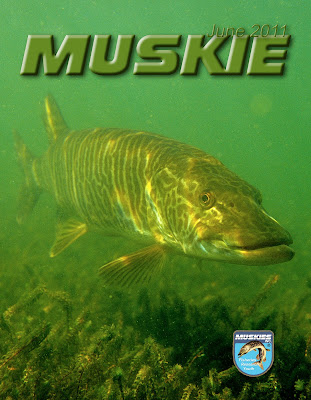In June 2007, Muskie
Magazine published an article I wrote about my underwater observations
photographing muskie. In the last
paragraph of that article I shared some conclusions I had made regarding muskie
preying on walleye. I said at the time
that I believe muskie routinely prey on walleye and cited many of my own
observations that led me to believe that.
In the last ten years, I’ve witnessed additional muskie
behavior underwater and while humbling, I think it’s only fair that I set the
record straight and tell you why I now believe I was wrong about my original
conclusions.
Here are the facts:
I have never once seen a muskie actually capture a walleye. Certainly, when walleyes are around, a muskie
will show interest as they do in all fish they encounter that might be regarded
as potential prey. I often saw muskies
following walleyes-a term I called ‘stalking” or “targeting”. On occasion, I had seen muskies “rush” a
walleye in what could only be considered an attack. The muskies were always unsuccessful. The conclusion I made from these observations
is that while I saw only misses, they
must be successful most of the time when targeting walleye. I now think that I completely misinterpreted
those observations.
Today, ten years after I wrote the article, I have a
different idea of what I really saw.
I’ve had almost a decade more to observe many more muskies interact with
other fish and I feel I’ve learned a great deal. I’ve now seen a great many “misses” and still
not a single successful capture. Today, I’m convinced that muskies actually eat
very few walleyes. The reason for this will
seem counter intuitive to everything you know about muskie, but it’s a
conclusion that seems well supported. I don’t believe muskie are very efficient predators…
at least not of walleyes. In reviewing my
underwater video of muskie attempting to prey on walleye, they fail time and
time again because of many huge disadvantages they have. Walleyes on the other hand, seem to be
uniquely designed for the purpose of evading muskie. Walleyes have excellent vision and are always
keenly aware of the location of any nearby muskie. It’s nearly impossible for a muskie to
actually “sneak up” on a walleye. My
videos show that walleyes are speedy and agile and they escape with very little
effort at all. Muskie, it has to be
said, are rather clumsy. They have some
speed but only for very short bursts.
Their long bodies are difficult to turn and they lack the mobility to
out maneuver walleyes. They have good
vision that they use to their advantage in low light when preying on perch or
suckers, but it’s no match against a walleye’s vision. The videos that I’ve taken underwater show
how positively feeble and overmatched muskie are when attempting to chase down
a walleye. In short, walleyes seem
specifically designed by nature to possess the exact traits needed to evade
muskie.
It’s not surprising that walleye fisherman sometimes have
muskie attack their catch as they’re reeling it in. Only a walleye already hooked and struggling
on a line would be incapable of escaping a muskie attack. When this occurs, it’s easy to assume that
muskie must eat walleye all the time. I
came to the same false conclusion myself.
But now I think only walleyes that are compromised ever become prey for
muskie.
For people who appreciate or even revere the muskie, it
almost seems blasphemous to suggest that muskies have any shortcomings
whatsoever, but I think they do. I now
believe that muskies don’t eat many walleyes, not because they wouldn’t want
to, but because they’re unable
to. At last, the mighty muskie has met
his match and it’s the wily walleye.















I seem to remember a study of muskie stomach contents which also showed very little "bony fish" found, almost always when a soft skinned forage fish like a sucker was available to eat. Do those crafty Walleys ever stop moving?
ReplyDeleteYes, you’re correct. The studies show that muskies prefer soft rayed fish as prey. There was a famous study done by the Wisconsin DNR where they examined the stomach contents of 1,092 muskellunge from about nine to 46 inches in length. Wisconsin researchers found 31 different species of fish in the stomachs of muskellunge, primarily perch and white sucker.
ReplyDeleteTom Burri, a Minnesota DNR biologist who worked on this study while previously employed in Wisconsin, said the diet study was enlightening.
“We found only five walleye in the stomachs of 1,092 muskellunge,” said Burri. “Muskie actually ate more muskie than walleye. We found six muskies inside of muskies.”
Burri said the Wisconsin diet study indicated that 98 percent of a muskie’s diet, by volume, was comprised of fish. The other two percent, he said, included crayfish, insects, mudpuppies, tadpoles and one mouse. Walleye, bass and northern pike ranked low in the muskie diet.
Super interesting! Didnt know walleyes were that good at evading such a "top predator" -musky. Wonder how the other top predator -n.pike, do in their walleye consumption.
ReplyDeleteWell, they evolved together in the same waters so nature has gifted walleyes with some extraordinary tools. I've actually spent a good deal of time watching northern pike feed and their attack-to-capture ratio is very low. Having the same body type as muskies they have a very limited turning radius that's a real handicap. Sometimes I'm amazed they can catch anything to eat at all. We only think they're super efficient predators because they're easy to catch. But remember, our lures never make evasive movements.
ReplyDeleteSurvival tactics between predator & prey! (walleye, musky & pike) Amazing & endlessly interesting! Appreciate you sharing info youve gleaned from your underwater view!
Delete